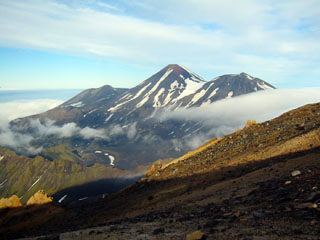Report on Tanaga (United States) — 15 March-21 March 2023
Smithsonian Institution / US Geological Survey
Weekly Volcanic Activity Report, 15 March-21 March 2023
Managing Editor: Sally Sennert.
Please cite this report as:
Global Volcanism Program, 2023. Report on Tanaga (United States) (Sennert, S, ed.). Weekly Volcanic Activity Report, 15 March-21 March 2023. Smithsonian Institution and US Geological Survey.
Tanaga
United States
51.885°N, 178.146°W; summit elev. 1806 m
All times are local (unless otherwise noted)
AVO reported that earthquake activity near Tanaga had decreased in both rate and magnitude from the peak of the swarm recorded during 9-11 March. More than 800 earthquakes, including multiple M2 and above events, were detected beneath Tanaga Island at depths less than 9 km below sea level during 11-17 March. The decline in activity decreased the potential for an eruption, so AVO lowered the Volcano Alert Level to Advisory (the second lowest level on a four-level scale) and the Aviation Color Code to Yellow (the second lowest color on a four-color scale) on 16 March. The Volcano Alert Level and Aviation Color Code for Takawangha (8 km E) were also lowered to the same level. Several M 2 and higher earthquakes were detected during 17-18 March, in addition to numerous smaller events. Earthquake activity persisted through 20 March.
Geological Summary. Tanaga volcano, the second largest volcanic center of the central Aleutians, is the central and highest of three youthful stratovolcanoes oriented along a roughly E-W line at the NW tip of Tanaga Island. Ridges to the east and south represent the rim of an arcuate caldera formed by collapse of an edifice during the Pleistocene. Most Holocene eruptions originated from Tanaga volcano itself, which consists of two large cones, the western of which is the highest, constructed within a caldera whose 400-m-high rim is prominent to the SE. At the westernmost end of the complex is conical Sajaka, a double cone that may be the youngest of the three volcanoes. Sajaka One volcano collapsed during the late Holocene, producing a debris avalanche that swept into the sea, after which the Sajaka Two cone was constructed within the collapse scarp.
Source: US Geological Survey Alaska Volcano Observatory (AVO)

